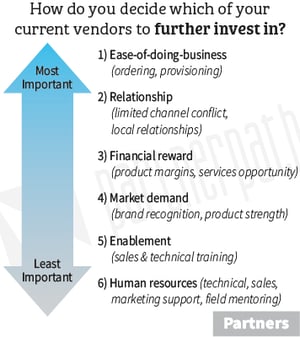
If a vendor makes it to the Growth stage (partners drop vendors and vendors drop partners – both at an average of 10% per year) it’s time for the partner to evaluate the relationship for future potential. At this point in the Partner Journey, they want to determine whether they’re getting the technology, experience, success and growth expected from their investment in a vendor. The hope is, as the partnership matures and mutual success is achieved, solid growth will start the partner journey over again at the Awareness stage.
 When measuring growth, there first needs to be profit. The solution provider respondents are split on their expectations of how long it should take to turn a profit with a new vendor. Half expect profitability within the first six months and half expect profitability within the second six months. The vendor respondents expect the partner profitability to be a bit slower. The overwhelming majority indicated a new partner should turn a profit in 6-12 months. Partners are likely to know best since they understand their businesses and the expectations on an investment in a new vendor. Regardless, expect at least six months of investment on both sides before the new partnership is profitable.
When measuring growth, there first needs to be profit. The solution provider respondents are split on their expectations of how long it should take to turn a profit with a new vendor. Half expect profitability within the first six months and half expect profitability within the second six months. The vendor respondents expect the partner profitability to be a bit slower. The overwhelming majority indicated a new partner should turn a profit in 6-12 months. Partners are likely to know best since they understand their businesses and the expectations on an investment in a new vendor. Regardless, expect at least six months of investment on both sides before the new partnership is profitable.
What stymies partner growth?
At this stage, the criteria for continued investment in the relationship changes again. The solution provider respondents prioritized ease-of-doing-business as the key criteria in deciding which vendors to further invest in. They indicate process complexity distracts from revenue-producing activities, slows their customer responsiveness and demands too much staff and support, subtracting from their overall profitability.

The solution providers ranked the unquantifiable metric of relationships as second in determining those vendors in which they should continue to invest. Issues like channel conflict (with other solution providers and/or the vendor’s internal teams), effective account managers, trust and executive-level support all affect the partner’s time, effort and energy and thus the cost of working with a vendor.
Holy smokes! Financial reward and market demand were only ranked #3 and #4? We expected these revenue-producing elements to be stronger driving factors of continued investment in the vendor relationship. Upon clarification, the solution provider respondents explained they wouldn’t have made it past the Awareness stage with vendors who didn’t provide significant financial reward or have a strong product. Pricing and product functionality were two critical criteria in the early stages of the partner journey and so play a less crucial role here. And if the relationship is bad, and you can’t get the business done – it doesn’t matter how big the financial carrot is.
A similar explanation accounts for human resources ranking last. People affect the partner experience most, in turn affecting engagement and success. Without those people being highly skilled, proactive and professional the partnership wouldn’t even make it to the Growth stage.
How aggressive is the growth potential?
There is a slight disconnect between the vendor and solution provider respondents on the expected rate of growth. The solution providers expect their businesses to grow at around 15% in 2018. On average, they expect to grow at this rate with their top vendors while a bit slower with their secondary vendors.
The vendor responses skewed toward more aggressive growth. They expected to grow with their top-tier partners at an average of 21-50% and with both mid-tier and entry-tier partners at 11-20%. It’s a bit overreaching to expect entry-level partners to invest enough to grow the business upwards of 10%. Usually, partners are in the lower program levels because they are unwilling, for one reason or another, to make the investments to grow with that specific vendor.
A caveat: we asked for these predictions at the end of 2017. Everything could change with the shifting economic and political climate. The U.S. House of Representatives and Senate passed sweeping tax-change regulations that could alter the economic growth in the United States and with our global trading partners. With record-low approval ratings for the President of the United States, who knows what could happen in the 2018 election season. 2018 could be a year of even more economic, legal and political maneuvering.
Subscribe to our blog to keep learning about the Partner Journey.
*In December of 2017, we surveyed 104 vendors and 220 solution providers on the people involved, priorities and expected outcomes of the partners’ journey.
Tips for your program:
Remove barriers to Growth
- Streamline your processes, invest in automation and become easy to work with. You think you’re easy – you’re not.
- Remove conflict – particularly with your direct teams.
- Plan for realistic growth targets and expectations of profitability. No one likes to miss the goal.




